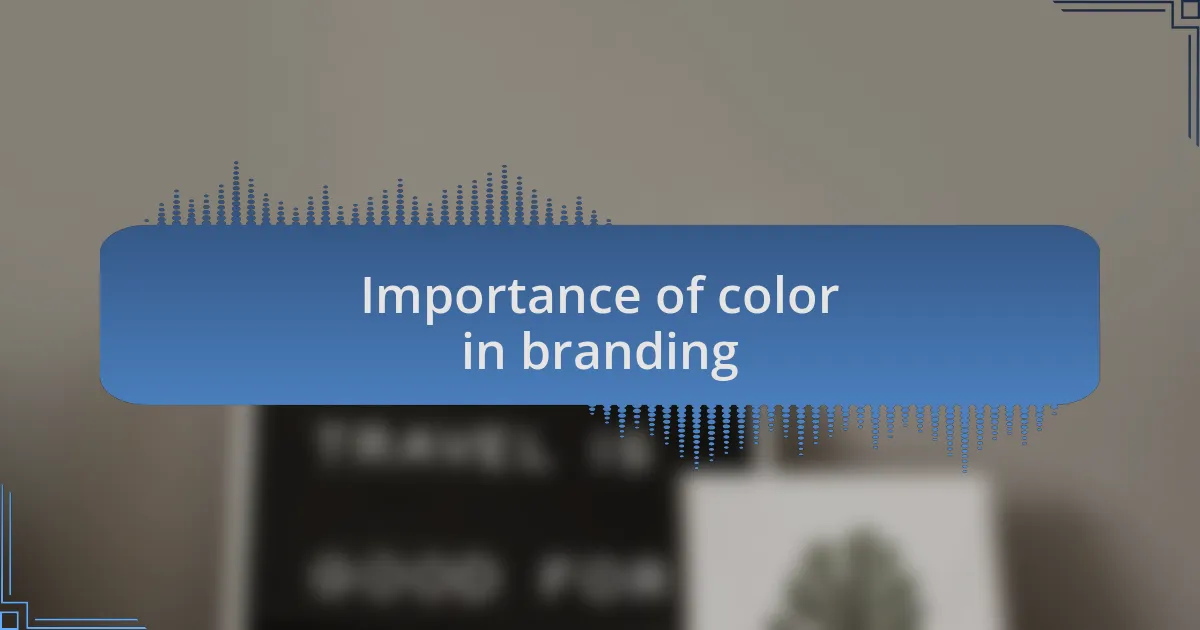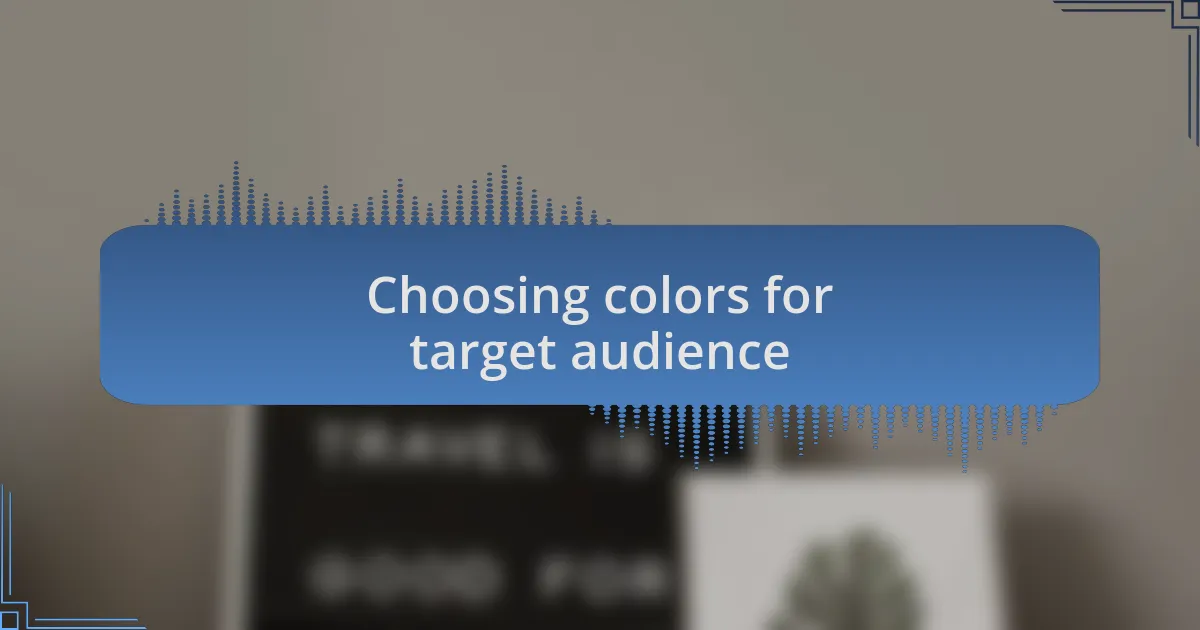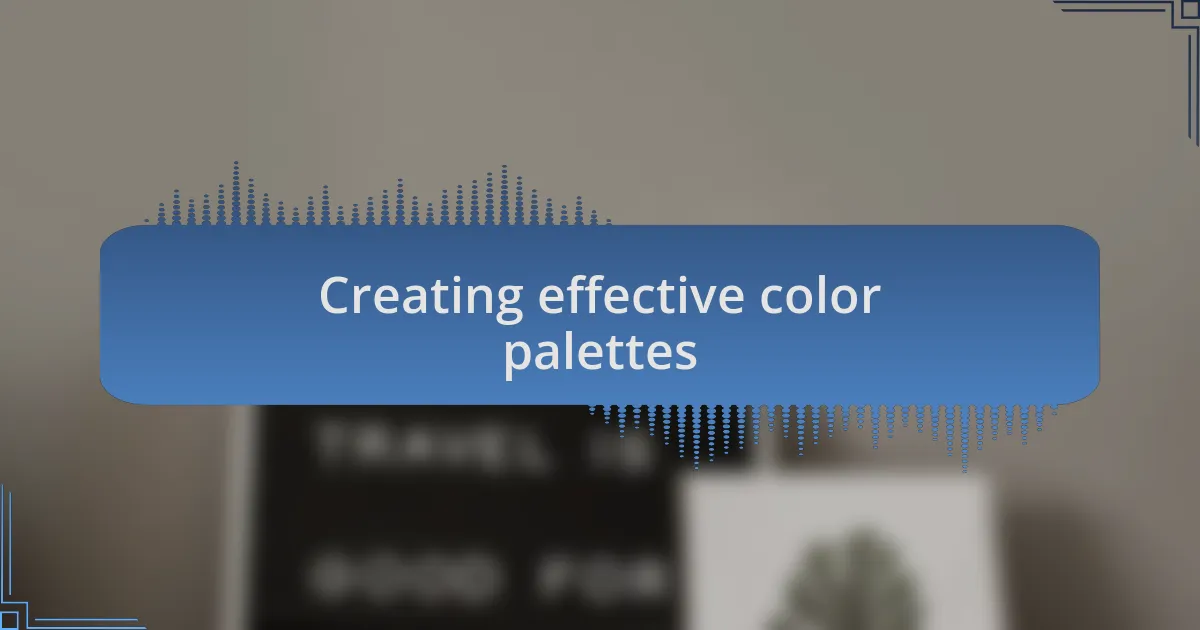Key takeaways:
- Understanding color theory enhances emotional responses and narrative impact in design, influencing audience perception and engagement.
- Choosing the right colors for branding is critical for aligning visuals with a brand’s identity and fostering emotional connections with consumers.
- Create effective color palettes by balancing personal preference and strategy, using principles like the 60-30-10 rule, and testing for audience resonance.
- Consider cultural interpretations and accessibility in color choices to ensure inclusivity and relevance in branding efforts.

Understanding color theory principles
Color theory principles are foundational in understanding how colors interact and influence perception. For instance, I remember the first time I experimented with complementary colors in a branding project. The contrast not only made the design pop but also evoked an emotional response from viewers, sparking conversations about the brand’s core values.
Beyond the basics of the color wheel, I’ve found that understanding the psychological impact of color adds another layer to the equation. Have you ever noticed how a bright yellow can uplift your mood while a calm blue can create a sense of tranquility? By consciously choosing colors based on their emotional resonance, designers can curate more meaningful experiences.
Moreover, it’s fascinating how color harmony plays a critical role in visual storytelling. I often consider how different color palettes can tell distinct stories. For instance, a warm palette might convey excitement and energy, while a cooler one may evoke serenity and trust. Engaging with these principles allows us to craft narratives that truly resonate with our audience.

Importance of color in branding
Choosing the right color for branding is more than just an aesthetic choice; it’s about aligning visuals with a brand’s identity. I still recall the moment I adjusted the shade of green in a client’s logo, aiming for a more earthy tone. That small tweak sent a powerful message about sustainability and responsibility, transforming how their audience perceived them.
Colors can evoke strong emotional connections that drive consumer behavior. Think about it—when was the last time you felt a surge of excitement upon seeing a vibrant orange? That’s how powerful color can be; it not only attracts attention but also influences decisions, often even before customers realize it.
When crafting a brand’s visual identity, the importance of consistency in color usage can’t be overstated. I once worked with a startup that used an inconsistent color scheme across their materials, leading to brand confusion. Once we established a cohesive palette, it was incredible to see the shift in recognition and trust from their audience. It’s in these details that a brand truly comes alive.

Choosing colors for target audience
Choosing colors that resonate with your target audience requires a deep understanding of their preferences and psychological triggers. I remember a project where we chose calming blues for a wellness brand primarily targeting stressed professionals. The moment we unveiled the new visuals, several clients expressed that they felt an immediate sense of peace, reinforcing the notion that color choices can significantly influence emotional responses.
It’s fascinating how different demographics perceive colors differently. For instance, I once had a meeting with a client aiming to reach a younger audience. Initially, they leant towards muted tones, but after discussing it, we shifted to more vibrant, bold shades. The energy in the room changed; you could almost feel the excitement. Those bright colors attracted not just attention but also engagement. How can something as simple as a color palette shape a brand’s entire image?
Ultimately, understanding the cultural connotations of colors is vital. I’ve seen brands falter because they didn’t consider how specific colors might be interpreted in different cultural contexts. For instance, while white symbolizes purity in some cultures, it represents mourning in others. I always advise clients to immerse themselves in research to see the potential impact of their color choices on their intended audience.

Creating effective color palettes
Creating effective color palettes involves balancing personal preference with strategic intent. I vividly recall a time when a startup sought colors that reflected their innovation and forward-thinking ethos. Together, we crafted a palette featuring vibrant greens and dynamic teals, echoing their commitment to sustainability. The excitement on their faces when they saw the colors come to life reinforced the idea that a well-chosen palette can truly embody a brand’s mission.
Moreover, I believe that combining colors should never feel random; it’s an art form. One approach that has served me well is the 60-30-10 rule, where 60 percent is the dominant color, 30 percent is a secondary color, and 10 percent is an accent. I applied this principle to a recent project for a creative agency, integrating a bold coral as the accent color. The feedback was astonishing—people were drawn to the visuals, and it felt cohesive yet energetic. Isn’t it incredible how deliberate choices can evoke such strong responses?
Finally, testing your color palette is crucial. In one instance, I recommended conducting A/B testing to a client who was uncertain about two different combinations. The results were telling; one palette resonated significantly better with their audience, leading to increased engagement on their social media. This experience solidified my belief that experimentation can unveil insights we might overlook. How often do we stop to evaluate what really works?

Tips for applying color theory
One effective tip for applying color theory is to understand the psychological impact of colors. A few years back, I worked with a nonprofit organization aiming to raise awareness for mental health. We chose calming blues and soft yellows to evoke feelings of trust and optimism. The transformation in their branding and community reception was profound—people felt a sense of hope just by interacting with their promotional materials. Have you ever considered how certain colors make you feel, and how that emotional response can influence consumer behavior?
Another key aspect is to consider color accessibility. During a project for an online retailer, I realized how important it is to choose color combinations that are easy to differentiate, especially for those with visual impairments. We adjusted a design by incorporating sufficient contrast, which made a significant difference. It’s fascinating how such adjustments can broaden a brand’s reach and inclusivity. How often do we think about the diverse audience that interacts with our work?
Lastly, seasonal trends can play an integral role in color application. I recall a furniture company that wanted to refresh their look for spring. We introduced softer pastels alongside natural earth tones to reflect the season and invigorate their identity. The uplifting response from both clients and customers highlighted that aligning colors with the changing times can be incredibly effective. Why not experiment with seasonal palettes to keep your brand feeling current and engaging?